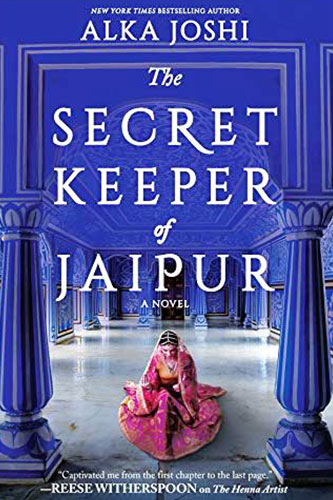Author: Alka Joshi
Publ: Mira, 2021, ISBN-13: 978-0-7783-1145-4
Alka Joshi is an Indo-American novelist who was born in Rajasthan, India and immigrated to the United States with her family when she was nine years old. She received her Bachelor of Arts from Stanford University and Master of Fine Arts from California College of the Arts. Her debut novel, The Henna Artist, was published in 2020 and became a bestseller in the New York Times, USA Today, Publishers Weekly, and more.
The Secret Keeper of Jaipur is Joshi’s second novel, sequel in a planned trilogy. It is set in 1969, twelve years after The Henna Artist, and sees the return of characters such as Lakshmi Shastri (now Kumar), Malik (now Abbas Malik), Samir and Ravi Singh, and Sheela Sharma (now Singh). While The Henna Artist kept itself firmly rooted in Jaipur, India, The Secret Keeper widens its scope slightly and splits the narrative between Jaipur and Shimla. The novel is still largely centered around Jaipur, however, and one major event that takes place there: the collapse of a balcony in the newly constructed Royal Jewel Cinema on its opening night, which led to death and destruction.
The debacle of the cinema project leads to unraveling many secrets: a gold-smuggling cartel, corruption in the construction industry, unfulfilled desires, and forbidden liaisons. Malik, a twenty-year-old man who has been raised by Lakshmi since he was a child, is in Jaipur apprenticing under Manu Agarwal, the facilities director for the Jaipur Palace, and witnesses the fall firsthand. When Malik suspects wrong-doing on the part of the Singhs who had the contract for building the cinema, he begins to investigate the matter on his own. He must try to discover who is responsible for the substandard building materials and labour that precipitated the collapse or else Agarwal is set to become the scapegoat for those with more power and influence than him. Malik is able to uncover the complete truth after Lakshmi returns to Jaipur to assist him.
When Malik is navigating corruption in Jaipur and untangling the mystery of the Royal Jewel Cinema tragedy, he is careful to protect his own identity and privacy while also guarding the secrets of those around him. When he was last in Jaipur (the period covered in The Henna Artist), Malik was an eight-year-old Muslim boy without shoes trailing after Lakshmi as she provided aesthetic services to high-caste Hindu ladies. During this period, he observed the secret lives of the upper-class, their excursions – sexual and otherwise, and the way Lakshmi navigated them as she tried to stay afloat through her work as a henna artist. Now, he is a private school educated, reputable Muslim man, and he struggles to leave the memories of the past behind to move forward.
In Shimla, Malik has left behind Nimmi, a recently widowed woman from a nomadic Himalayan tribe and his love interest. Malik, Lakshmi, and Nimmi, in the midst of the intrigue surrounding the Royal Jewel Cinema, must also navigate the drama in their own lives. Nimmi has two children, Rekha and Chullu, with her deceased husband, Dev. She is facing many uncertainties as a widowed mother who has broken away from her tribe, and she sees a potential future in Malik. However, when Lakshmi sends Malik to Jaipur, Nimmi’s insecurities regarding her lack of concrete ties to Malik continue to grow the longer he is away. Then, a new tragedy is brought into her life due to the illegal smuggling of gold into India. The smugglers exploit and endanger Nimmi’s people in order to facilitate the demand for gold jewelry by the upper-class/caste living in cities like Jaipur to display their wealth. The novel weaves together these seemingly disparate events in a well-knit plot.
The Secret Keeper builds upon themes, such as the exploitation of the lower-class by a corrupt upper-class abusing their privilege, that Joshi introduced in The Henna Artist. Other important issues touched upon include the rampant nepotism in post-Independence India, the treatment of women and of sexual and religious minorities, and the concern for one’s social standing.
Also, in keeping with The Henna Artist, The Secret Keeper caters to a Western audience. The continual italicization of non-English words, even of words that are commonly known in the West (like tikka masala), falls behind the wave of postcolonial authors refusing to see their non-English languages as ‘other’. Explanation of minor details about India and its culture (such as the length of Hindi films or the use of the term Bollywood which was not common in the 1960s, the time of the novel’s narration) furthers the Orientalizing tropes in both novels. Additionally, the simplistic map of South Asia presented at the beginning of the novel, presumably there to illustrate to an audience lacking in the basic geographical knowledge of South Asia, sets an awkward tone.
In The Secret Keeper of Jaipur, Joshi uses multiple first-person narrations to move the plot forward. The plot is suspenseful and keeps readers engaged, especially in the second half. Joshi has a keen eye for detail and the descriptions of sights and sounds are captivating. The characters are well-rounded and intriguing. The book is readable on its own and one does not need to have read the first book in the series.






